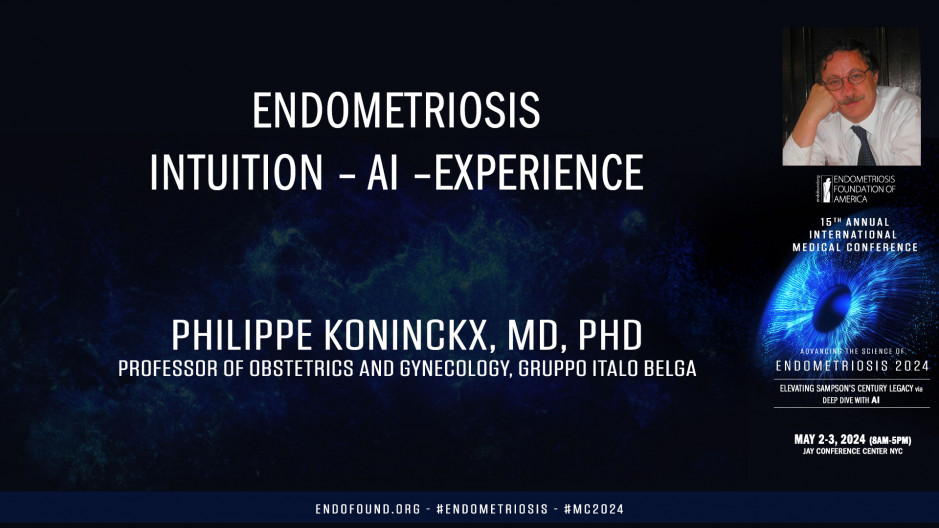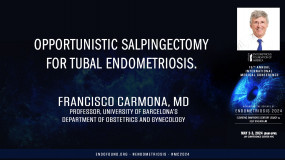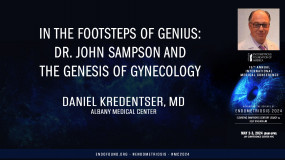International Medical Conference
Endometriosis 2024:
Elevating Sampson’s Century Legacy via
Deep Dive with AI
For the benefit of Endometriosis Foundation of America (EndoFound)
May 2-3, 2024 - JAY CENTER (Paris Room) - NYC
Thank you for the opportunity. Thank you for being here and the invitation for the audience. I am a clinician and what I'm going to try to tell you is that we have been teach that treatment should be based on evidence. Second 9 22, this is average effect on the average woman. We talked already about this one. What I didn't dare to put on the slide is that I think this has done a lot of harm. This evidence-based medicine by omitting experience and one of the people I do remember is 3D Bush at a SRM, this is around 2000 from NNIH. And talking about randomized control trials, she said I would put my money on observational medicine. So just a favor of Beijing thinking you meet a girl and you think she might be interested and then she smiles and then you update your opinion. You see this is progressively updating from the fast. What does these do? This is about three things. This is about uncertainty. You are not certain that she is interested. She'll get back each experience a little bit more. Sir, this is because of your past experience if girls were interested or not. And there are many aspects about attitude, about smile, about many multivalent to go to clinical medicine. It's exactly the same. It is a probability, it is experience-based and it's multi valued. And just to fix id I would say when are you going to do surgery for the ovarian cyst?
And this is something we did, we asked the local physician, when are you going to do surgery? And if you have more pain, more probability of surgery. And if you have more than seven of 10 vasco, most of them do surgery. And if the system is bigger, more surgery and if the woman is older, above 50, most of them are going to do surgery. But you see that one factor alone as a clinician it's closely irrelevant. You always take care of the three factors together. And then I have a problem, a randomized controlled trial with three factors together. You cannot do, you cannot do because you have randomization problems and randomization problems for three factors, at least eight groups, it's not feasible. So there is a problem with randomized controlled trial and for those who like a little bit mathematics, I would say one factor is a line, just a gradient does not be always in the same direction.
With can be irregular. Two factors is a square something and three factors is a sphere, irregular sphere. So you see this is decision making. Decision making and medicine is having much more than that. To put another way, one factor is traditional statistics. With P value zone two factors, you can already go with mild variant if you go for 4, 5, 6 factor and so on, you don't get it calculated anymore. And then you go to numeric iteration and so on. It's only 2000. By 2000 we were able to do this mark of chain mon computations and artificial intelligence is the next thing. And if you have all these factors together, together with experience, I think then you can close to clinical medicine. So this is my problem today with management of anti endometriosis, frequently statistics and P value, those who follow this, the P value fallacy, you cannot confirm a hypothesis with a P value.
There is no prediction and it's a postdoc. You analyze after the things happen already and there's some subjectivity. If I throw a coin like this, you say what is the probability of head of tail? You say 50%, yes, but your subjectivity is you assume that a coin is honest. So there's already an assumption. So the problem of randomized controlled trial, you cannot have multi value and you cannot have anything like rare problems. If you have something which is 1%, you need a randomized trial of 6,000 in order to have 30 cases in the control room. It's I my conclusion for randomized control trial today, it's an excellent tool to avoid bias is very limited in real life you cannot blind and for endometriosis you cannot blind medical therapy. It's not suited for multi effect. And most randomized control thigh, if you look very well and this you in the metaanalysis, it's rarely perfect.
And then you see in the applications of evidence-based medicine, they include all other data available and then interpretation of vessel and they've got the grades of evidence. And at the end of the study you go to the guidelines and aco ashray A RM, they're pretty different. So you see that all this logic of evidence-based medicine result in different guidelines. Not going to dwell in details on traditional statistics and basin statistics, but as basin is mainly predicting the future, is it going to rain tomorrow? If you say it's not significant, it's going to predict tomorrow. That's not what you want to know. If they say 60% to rain and 40% is not going to rain, this is a prediction. And medicine is thinking basic medicine is not thinking traditional statistic. And as a clinician I realized that evidence-based medicine and then unfortunately they use traditional statistics is very limited.
And it just a simplification of reality because in 1,990 they were not able to calculate it differently. They were not able to do what I think for and then the end of the day we have very little evidence. There's no animal model, it's a heterogeneous disease and we know very little you cannot blind medical therapy. There are no randomized controlled trials of surgery because the numbers by surgeon are not. They're lot of doctors. And what I would like to after this is that to change the expert opinion to collective opinion, the collective opinion, what is this? This we witness STR a few years ago we asked to everybody there cumulative experience of more than 10,000 deep and material surgery. What do you think about this? When are you going to do laparoscopy? When, okay, just practical one to 10 physio analog score. And so with this kind of data, the first thing what came out of the collective experience of all the questions that he asked, there's not one conflict with evidence-based medicine, which means the clinician had already seen the evidence, the clinician already loses the evidence but goes much further than that.
And this I think is the second part and the most important is that evidence-based we set what are the limitation but you have the whole population and all the women endometriosis, all those with melting mobility, all those the rare events, the complications of surgery and this in fact is collective experience. So I go for diagnosis. This is a simple example of a diagnosis. You begin with the age of the woman and the alside and the symptoms and the exam and then imaging and all test and what do you do as a clinician? You think it might be under osis but maybe it's something this and maybe you get a series of potential diagnosis. This is all with their probability and they say yes, but I should not miss a cancer rare events which you should not miss and all this together progressively narrowing very nice recent papers to document this.
This is a diagnose, try to do this with mathematics. I think today it's not possible. Try to do this with artificial intelligence maybe in the future but not yet today. So we said with this, with a group of clinician, we are going to sit together and say let's, these are the author authors, you have seen them before. Let us then see what you should not do in the management of an element. These are the 10 cardinal sins. What should you not do? And this I said I had have a problem with Samsung. Come back to that later. If you believe in implementation, it's one disease. If you see it's something which is erratic, epigenetic, genetic, whatever, you get several disease and it's not surprising that the diseases are different. That medical treatment, 30% do not respond and the order do respond very well. So you have a variable disease and just to shock a little bit and to shake this is puberty and infertility.
I think this is the predisposition that we had this morning from Stacey. This is women within the osis are already different already in their cells. This is what I call the predisposition. And I bet you if you're going to look at the gestural zone before pub two, it's already there. The probability of developing and mets. We seem to know that pregnancy is going to limit the disease. This is something which we have. This is for typical diseases for deep disease, for whatever. You see all the individual patients between 20 and 45 years old, which we operate in about. This is about 1500 women with deep an osis. And the fast thing you see there's no difference with H. Maybe the mid age are a little bit less patient. They have no real difference, which means they do not keep on growing. Second what you see the retina and the blue and do that.
These are the pregnancies. One, pregnancy, two, three, pregnancy. It's no difference. So this is what I call observational medicine. We made a plot of all the patients where we did surgery and you see that most of them are around 28 years old, somewhere young. And then it goes down. If you have a delay, you take a delay in diagnosis of 10 years. Then you have this curve, the red curve, which means that most of the endometriosis initiate during puberty. And if you haven't endometriosis yet by age 30 little risk, you're going to develop it. So the risk, and this is normal I would say is like cumulative pregnancies in fertility, not understanding the diagnosis. What is a test for research and is sensitivity and specificity for the medical student is the predictive value. He wants to know if the test is positive, if this lady has endometriosis for the clinician it's a predictive value of manifest.
And then you see they cannot calculate today a little bit, maybe a little bit of in invasive you can do maybe and still it's not easy. And then you have what he is interested is the other value of a test. You have seen the patient, you have done an ultrasound. If it's well tried to do an MRI, that is the other value. And then you see that by looking at this. The combination of many tests is difficult and the predictive value depends on the prevalence. We knew that today basically we know it very much better. 1% of cancer you have a test, 99% sensitivity, 90% predictivity. That's a very good test. But it means that you have 99% a predictive value of 50%, which I would say predictive value of 50% toco it's the same value. So it's not very useful. And if it's less rare than that and I'm not going to talk about breast cancer, then it's even more important. So I come the same thing. This what we published last year in Jamie. When you apply this to ultrasound of endometriosis F, everybody seems to know it works. What is there about let's say deep end, end anti materials prevalence? Three, 4% in population. If you have an ultrasonographer who has not less than 10% in his population, you are there which means you are around 50% of predictive value, which means don't do it.
Sin, dogma and mistake and imaging cannot rule out endometriosis over volume. Imaging circling thinking this is the one who say you IMC and this and this and this and death and I do a bowel resection. They are never data where you have this kind of randomized before. You have no data on end on imaging of an endometriosis when the image is blinded to the disease. Medical therapy when surgery is not indicated, I'm not going to dwell on this. We can discuss this but I ask irrational exaggeration of the complications. They continue medical treatment although the patient is still pain and I can imagine because the less experienced surgeons always worried to go in but it could be unexpectedly different and there are a lot of improving beliefs about the role of progestin stone. This is too far. Medical therapy is variable disease efficacy. Blinding is not possible.
Most of them because the woman is nose whether she takes active therapy and which means that if you have a variable disease, this is if the disease is variable by definition you cannot use statistics because statistics, basic assumption of statistic is you have a homogeneous disease. This is something which we wrote at the moment and just to look here, if a treatment is going to improve at 80% and make it worse than 20%, you'll never see it unless you see, look at the individual data, you're not going to see it. These are the data that these two types is well confirmed. Poor fertility surgery, we came from fertility surgery. The discussion of diagnostic laparoscopy. I've only seen one woman with these tubes hanging but without doing diagnostic laparoscopy, there's a lot of information or the fertility you are going to miss not discuss this in detail.
The quality of surgery has decreased. I think this is very clear. Before this was microsurgery, this was centralized today if everybody's doing and IVF, I'm not going to do IIVF. But don't ask the wrong question. Don't compare effect of IVF and confect surgery and forgetting that you could do surgery. And then IVF and the series are too small. The dogma of complete excision. I'm not going to discuss this also, but it remains a personal judgment based on the experience and skills to balance the completeness of excision and maybe sequelae and leaving some fibrosis, other, some belief. We discussed this recently. This is bleeding and endometriosis. Few people have seen endometriosis bleed. It had a pathologist who saw a remnants of bleeding. This is not bleeding, this is vascular instability. This is leakage of blood, the shoe shop syndrome. All shoe shops sell shoes from their shop and consider what we have in an osis.
We have an infertility and pain and infertility and in specialist infertility in medical. And this kind of, let's say referral is not always as good as it should be. We can discuss this evidence-based medicine not considering experience I think is a major, major problem. Absence of quality control and surgery. They asked me for the academic of surgery in Paris to give talk about this and my conclusion was it is the far west because for surgery we do not have anything. We have no rules, we have no checks, we have almost no data because of complexity and not enough number compared this for medical therapy where all this is very well organized and the start of the conclusion, if I would be minister of health, I would save money and I with half the budget, I would invest in good surgeons. Mandatory video registration and debriefings after surgery.
C nine pool training of surgeon and we only had 10 tensions. The training schedule of a footballer of a tennis player is much better organized than a surgeon. A surgeon becomes a surgeon like a hairdresser. He begins to wash and a little bit and then that's how he becomes a hairdressers and they are very few data loop and not security. This is something within 30 years. I think only today we begin to understand not going to say anything about political and financial aspects to come to the last thing. This is of personal biases. I think nobody's free. We all have some ties to somewhere. Nobody's really free. And with this, okay, at this moment we're writing together with a series of people here in the room, the 10,000 scenes of surgery. This is the same way of doing and I hope that I transmitted one message, is that an opinion with new data gets a new opinion in basis of this. They call this a prior plus. New data is a posterior and for us, I would say evidence-based medicine data plus experience against to be clinically useful. Thank you for your attention.










